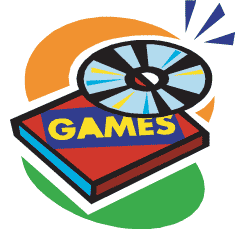 |
 |
 |
 |
 |
THE SCIENCE OF LEADING GREAT GAMES

Games aren't just for playing around!
by David Goebelbecker, Kidco Labs

Games are an important element of any children's program. They help generate energy,
stimulate teamwork, and can be used as teaching tools to reinforce the message in a fun
and entertaining way. Actually, it isn't the games that do all of this; they are only a
catalyst. The real power is in the leaders and in the children in your ministry every
time you come together to play. And the best is that all of the games that we have created
in this series serve as object lessons. So the kids aren't just having a good time, they are
learning too!

Some people are a little intimidated with the thought of leading games because they don't have a
"game show host" temperament. That might be nice, but not necessary. Anyone can lead a successful
game with a little preparation, a little practice and the help from a few simple tricks.

|
 |
 |
TIP 1 – PLAN FOR YOUR GAME

Planning with this series should not be too difficult because most games and activities have
already been outlined in the lesson plan. The only part that you will need to do is gather the
materials needed to play it. Most of them are things that you will need are common household items,
but there are some cases where some preparation is needed.

The day of the service, talk to the leaders so that they know the game as well. You may even want
to walk through it with them for fun. It will help create genuine enthusiasm when it comes time to
play with the kids.

|
 |
 |
 |
TIP 2 – BE ENTHUSIASTIC

It is hard for kids to get excited about anything if the person leading isn't, and getting kids
enthusiastic isn't hard. Ask a child if they want a plate of broccoli, and they will make a face,
but as if they all want to play a game and they will all shout cheerfully in agreement.

I usually have game elements visible from the time that the children enter the room—tape on the floor,
pieces of rope, a bin filled with noodle pieces, etc. And every week I will be asked what the items
are for. The have learned that I usually won't tell them much about it. My standard answer is that it is
part of what Headquarters sent them and I can't talk about it until it's time. For some, not telling
them is enough to make them anticipate even more about what is going to happen. The questioning becomes
a playful game to itself.

TIP 3 – KNOW THE OBJECTIVE AND THE RULES

Games should be simple to understand and have a basic objective that is easy to grasp. I am accustomed to
dealing with children from 5 years old up to 5th grade, so it needs easy enough for the youngest to
understand, but exciting and cool enough for the 5th grader to want to do. In most cases, all of them are
excited from the start, and using the leaders or a few volunteers from the group to demonstrate a quite
round helps to clear up any confusion.

TIP 4 – GET THEM ALL INVOLVED

Most games are played with a set number of players, so no matter what size your group, there will always
be a number of children that will be sitting out per round. The important thing is to help them understand
that each game of every week offers a chance for everyone to play. Let the children know how many people
will be playing each round, then select the groups for those rounds.

Let the children know how important it is to cheer and encourage their teammates, because they would want
it when their turn comes. In most cases, the overall teams are set as boys vs. girls. It's not hard to egg
them on and get them excited about their teammate's progress.

If you have enough leaders, you may even want to assign one to each team as a cheerleader. It will then
be the leaders responsibility to keep the kids excited and cheering for their team (and laughing at the other).

TIP 5 – MAKE ROOM FOR EVERYONE

Space planning is important. In order for the children to remain excited, they need to be in a place where
they can see what is happening. As you plan the service times, make sure that you know where you are going
to play the game and how much space you will need to keep it visible for everyone.

NOTE: If the games are part of the closing exercises, I have some of the children stack the chairs out
of the way, and sit on the floor around the designated game area to allow better visibility, more space and
a bigger sense of being on the sidelines of a big event.

TIP 6 – A MUSICAL DIFFERENCE

No matter what the game is, appropriate music will enhance it. For louder, high-energy games, I usually use
music that has a lot of drive and excitement. I crank up the volume and let the game begin. For review games
and challenges, it's fun to have slower music. I recommend that you find a handful that you think work and
add them to your storehouse of tools and resources.

For those that are more technically savvy, there are all sorts of buzzers and sound effects available for
the computer and can be downloaded for free and used during the game. Although they are fun to use, they
require a dedicated person who really knows what they are doing in order to prevent the sound effects from
being a distraction.

NOTE: There are CD's with game show theme songs available. I've used the music from Jeopardy for review
games many times. What's great is the kids all start humming and singing along, with a loud buzzing noise
directed at the opposing team at the end. Talk about involvement!

 |
 |
 |
 |
 |
Additional Online Game Resources

If you are looking for new game ideas to incorporate into your weekly lessons, we have supplied links to
many that offer suggestions with little to no cost. Many of these can be dressed up with things that you
already have around the house.

Click here for links to Online Games Resources >>

|
 |
 |
 |
 |
TIP 7 – MAKE THE GAME MEMORABLE

After playing a complete round of the game (or two) of closing games, take a minute to explain how it ties back
into what they have learned. Be brief, direct and to the point. Then, look at the scores and challenge the
children to another round to see who really knows what the game is all about.

For group activities and memory verse games that are part of the service, the explanation can come at the end
of the game. These explanations usually help transition from one lesson element to another and are used as time
to get set up for the next stage of the service.

TIP 8 – GET FEEDBACK FROM THE KIDS

At the close of every service, ask a few of the kids (or have your leaders ask) how they liked the games.
Find out which was their favorite and why. I also ask if they would want us to play it again sometime in the
future.

Kids are brutally honest, and this is the time and place that you will know how things are working. I have a
few kids that I trust their feedback, because they too have a heart for God and for ministry. Their suggestions
are always welcome.

From time to time, I even ask them to rate the game for me on a 1 to 10 scale. They can't all be 10's, but
for those that are, I keep in mind for those times when I need to pull something together fast.
|
 |
 |
 |
 |
|
 |
 |
 |




Articles Overview

Powerful Praise and Worship

The Science of Leading Great Games

Creating An Effective Environment

Leading Children To Christ

Creating Custom T-shirts

Making Custom Hats

Using Fonts Effectively

Add A Little F.U.E.L. To Your Lesson

Is Your Ministry Running On All Cylinders?

Live. Laugh. Learn.



Resources Overview

Leader Resources

Game Zone

Worship Resources

Download Center

Articles


|
 |

